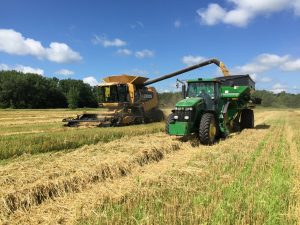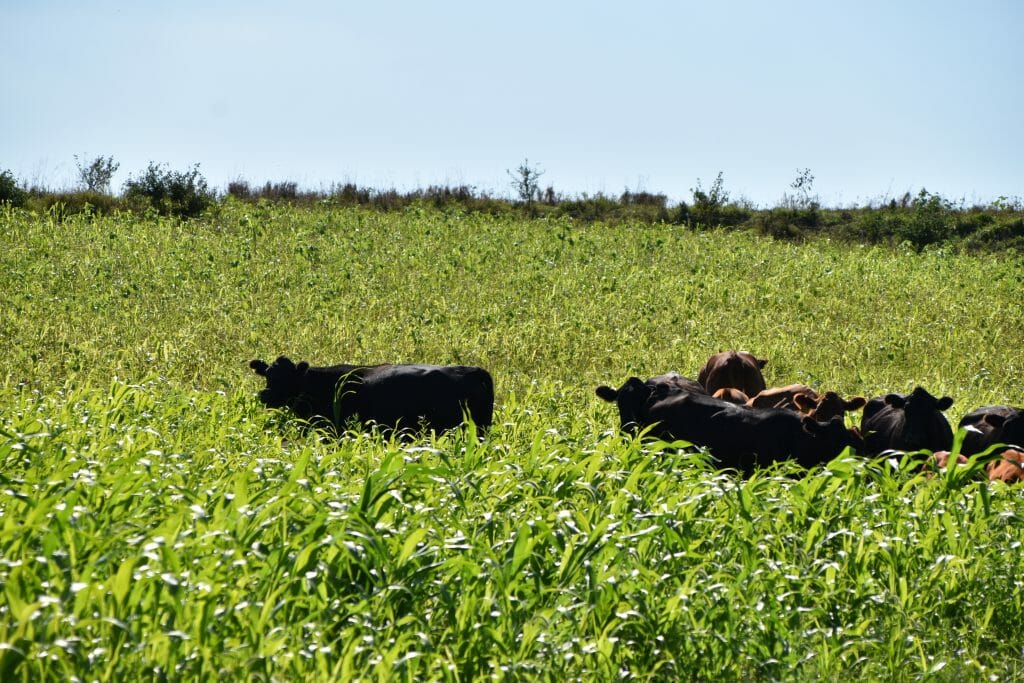How to Apply for EQIP Funding for Small Grains Production
Were you bummed that you didn’t get to sign up for PFI’s small grains cost-share before we ran out of acres for 2019? Are you worried there are no other ways to access financial assistance for your small grains? Fear not!
With a few tips and tricks, it is possible to secure Environmental Quality Incentives Program (EQIP) funding from USDA’s Natural Resources Conservation Service (NRCS) for extending your corn-bean rotation with a small grains crop followed by a cover crop. If you’re planning to plant a winter small-grain in the fall, like winter wheat or rye, you’ll need to act quickly and submit your application by Friday, March 15 in order to be included in the next batch for priority consideration.
What is EQIP?
EQIP is a federal cost-share program for farmers who implement one or more approved practices. Though EQIP applications are accepted on a continuous basis, March 15, 2019, is the deadline to submit mid-year 2019 applications for a timely response. If you miss the March 15 cutoff, you may still be able to get funding for an October-planted winter small-grain, but you should submit your application as soon as possible for the best chance to have your paperwork completed by NRCS in time to plant. Approved practices are determined on a county-by-county basis depending on the environmental and conservation needs of the area and the applicability of your practice(s) to address those needs.

Mark Glawe, of Garber, speaks to field day attendees at a Clayton County Soil and Water Conservation District and Iowa Learning Farms field day he hosted in 2015. He will use EQIP practices 328 and 240 to plant oats followed by a diverse summer cover crop this year.
Mark Glawe, who farms near Garber in Clayton County, is planning to use EQIP to plant oats this year and follow it with a summer cover crop mix to provide grazing for his beef cattle.
“My biggest interest is that I usually run out of pasture come August and September for my beef herd,” Mark says. “My cornstalks and aerially seeded cover crops into corn and beans aren’t ready until October or November, so this will give me a place to put the cows out earlier.”
“I also want to build soil health,” Mark adds. “I’ve always wanted to try an eight- or nine-way mix, and this is the best way to do it. If it works out, I want to get away from making hay – because where I’m making hay, my organic matter isn’t rising, which is counter to my soil health goals.”
Combine EQIP Practices for Best Payment
Practice 328 for conservation crop rotations is ostensibly the correct EQIP practice number to describe adding a year of small grains production into a rotation. Historically, the payment rate for Practice 328 included compensation for foregone income – this set the payment rate at about $40 per acre, a competitive incentive for growing more small grains.
However, foregone income has since been removed from the payment calculation, so current payment rates for Practice 328 range from $5 to 10 per acre – which in many cases is not lucrative enough to make the transition to a three-crop rotation due to a lack of reliable markets for small grains in the Corn Belt.

Small-grains harvest typically occurs in July, leaving a longer window to establish cover crops. This timeframe gives growers a chance to take advantage of multiple EQIP practices that can then provide adequate financial support for diversifying a corn and soybean rotation with small grains and more diverse cover crops.
In Iowa, Practical Farmers and Iowa and NRCS worked together to find a solution that would compensate farmers more competitively. Growers can enroll concurrently in Practice 328 for conservation crop rotation (the small grains crop) and Practice 340 for cover crops. Many farmers making the transition to a small-grain are already planning on using that longer summer window after small-grains harvest to establish a cover crop – so this pairing is a natural fit.
Moreover, combining the payments of $25 to 40 per acre for the cover crop with the $5 to 10 per acre for the small-grains crop gives a farmer $30 to 50 per acre of support to work with. This is much more feasible than the conservation crop rotation payment alone. More farmers are starting to use this combination. In Iowa, 600 acres were enrolled in both practices in 2017, and a little over 1,000 acres were enrolled in 2018.
Your Local NRCS Office Can Help
Your county NRCS office is the best resource for getting help with an EQIP application and learning what will be required under the contract. For cover crop Practice 340, the requirements will stipulate the number and type of species required in the cover crop. They’ll also specify seeding rates and seeding deadlines. Under NRCS rules, a straight underseeding of clover or alfalfa under your small-grain does not qualify as a cover crop. Your underseeded clover or alfalfa would need to have something else seeded into it after small-grains harvest to qualify. If you’d like clover to be your primary cover crop, you should consider putting skips in your clover seeding this spring so you can interseed radishes or another species in August.
And – good news – if you’ve already used EQIP Practice 340 to plant cover crops before, in Iowa there is no longer a lifetime dollar cap on collecting Practice 340 for cover crops. Last fall, Iowa NRCS announced that it was abolishing dollar caps for a few key individual practices, including Practice 340 for cover crops and four other practices.
Now, the only cap you need to be concerned with is the EQIP-wide cap for all cumulative practices of $450,000 per individual. So, if you’ve previously used Practice 340 for cover crops in a conventional crop rotation, that should not preclude you from using it again in combination with Practice 328 for conservation crop rotation with a cover crop.
“I’m starting out small, only going to try it on a 20-acre field to start,” Mark says. “Hopefully I will see the economics of it. That’s how I always use the government programs. I see if it’ll work, and then if it does, I’ll keep doing it on my own. I now pay for all my own cover crop seed myself on corn and soybean ground. I’ve been doing it several years because I see the benefits.”
Plan Ahead
A good rule of thumb for EQIP is to submit your application about six months ahead of when you want to begin work on the practice. So if you have a winter small-grain in mind for 2020 that would be planted in October 2019, you should work to submit your application by the next priority batching deadline of March 15, 2019. If you’re more interested in a spring small-grain such as wheat, oats or barley, then you should be aiming for NRCS’s other priority batching deadline, which most years falls in mid-October. The exact date for the October 2019 cutoff has not been announced yet.
All approved practices qualify for 50 percent cost-share, but certain factors – such as having status as a historically under-served farmer, or when a practice aligns with federal initiative policies – cause the cost-share rate to climb to a maximum of 90 percent. Though formulated as a percent, the payment is actually a flat rate based on the cost of implementing the practice in your area. The best way to figure out the payment rate for your specific case is to talk with technical staff at your county NRCS office. You can locate your county office on the NRCS website.

Cattle amble through a lush summer cover crop on Sept. 10, 2018 that was planted after oat harvest on Mark Peterson’s farm near Stanton in southwest Iowa.
